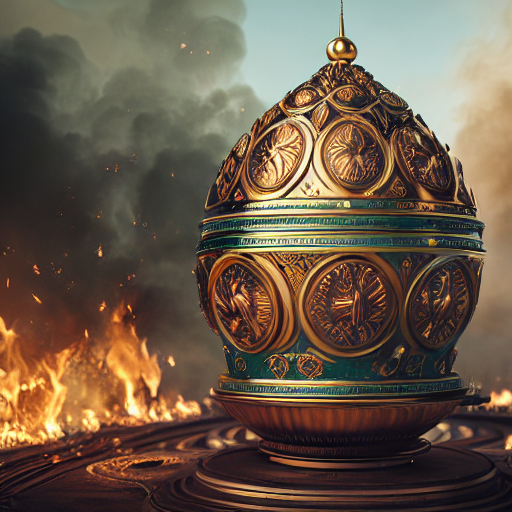Welcome to a captivating journey through the enchanting world of Faberge eggs. In this article, we will delve into the history of these exquisite treasures. Exploring their fate before, during and after the Russian Revolution. If you’re eager to learn more about the era before the revolution, be sure to explore our blog for in-depth articles on the various eggs created 100 years ago.
The Romanov Era – Before the Revolution?
The questions most of us ask ourselves addressing the post revolution state in Russia was: how Many Faberge Eggs Were There Before the Revolution? The renowned House of Fabergé crafted 50 Imperial Easter eggs for the Russian royal family. These were truly one-of-a-kind masterpieces, each with its unique design and hidden surprises. The fate of the Faberge eggs during and after the Russian Revolution (1917) varies.
Eggs that remained in Russia
Some of the Fabergé eggs remained in Russia after the Bolshevik Revolution in 1917. When the communists seized power and the Russian monarchy, including the Romanov family, was overthrown. Initially, the eggs were considered part of the state’s wealth, and some were kept in museums and state collections. However, during the turbulent years that followed the revolution, many valuable items, including some Fabergé eggs, were sold or smuggled out of the country as the new Soviet government sought funds and resources to support its policies. Over time, some Fabergé eggs were either lost, destroyed, or sold. For example the Alexander III Equestrian Egg (1896), Hen Egg (1885) and Order of St. George Egg (1916) were 3 of the eggs that remained in Russia after the Revolution (in addition to many others)
Eggs that were moved outside Russia’s borders
Some Fabergé eggs, along with other treasures, were taken out of Russia by members of the former Russian aristocracy and individuals who fled the country to escape the political upheaval and persecution that followed the revolution. These eggs were often sold or passed down through generations of emigrants and collectors. Many of the Fabergé eggs that are still in existence today are part of private collections, museums, or have been auctioned off over the years. It is very difficult to identify the exact eggs that were moved out of Russia right after the 1917 events. We can assume that the eggs that were considered lost but popped out few decades after the revolution. Were the ones that were smuggled outside the country.

Source – https://playgroundai.com/post/clm84pysd08mis6010ug1zcnn
Transition of Power
As for the transfer of power between the royal family and the communists. The Russian Imperial family, including Tsar Nicholas II and his wife Alexandra, were placed under house arrest following their abdication in 1917. They were eventually executed by Bolshevik forces in 1918. During this time, some of the Fabergé eggs that were in their possession may have been confiscated or taken by the new government.
The fate of the Faberge eggs during and after the Russian Revolution varied widely. With some remaining in Russia and others leaving the country. Many of them were scattered across the world, and their ownership has changed hands multiple times over the years. Making them valuable and sought-after artifacts in the field of art and collectibles.
How Did the Communists Treat the Treasures That Fell Into Their Hands?
After the Revolution, the treatment of treasures, including Royal Faberge eggs varied depending on the specific circumstances and policies of the time. Here’s an overview of how these treasures were treated:
Confiscation and Nationalization
In the immediate aftermath of the revolution, the communists confiscated and nationalized many valuable items. Including those belonging to the Russian Imperial family. Some Fabergé eggs and other treasures were considered state property and became part of the national heritage.
Sale and Disposition
In the early years of Soviet rule, there was a push to sell valuable assets to raise funds for the government and support its policies. Several Fabergé eggs and other valuable items were sold through auctions, including the following:
- Imperial Coronation Egg (1897) sold in 1927 to an American collector, Armand Hammer.
- Romanov Tercentenary Egg (1913) sold and ended up in the United States.
- Blue Serpent Clock Egg (1895) sold and eventually acquired by Lillian Thomas Pratt, an American collector.
Dispersion and Display
Many Fabergé eggs were dispersed among various museums and state collections within the Soviet Union, where they were displayed as cultural artifacts. Some Fabergé eggs were given as diplomatic gifts to foreign leaders and dignitaries.
Loss and Damage
The turbulent times of the Russian Revolution and the ensuing Russian Civil War (1917-1923) led to the loss and damage of numerous treasures, including Fabergé eggs. Some Fabergé eggs were damaged or destroyed due to neglect, theft, or the chaos of the period. The exact fate of several Fabergé eggs remains unknown, and they may have been lost during these tumultuous times.
What Did Peter Carl Faberge Do After the Revolution?
After the Russian Revolution in 1917 and the fall of the Russian monarchy. Peter Carl Faberge and his business faced significant challenges and changes:
Exile in Europe
After the revolution, Peter Carl Faberge and his family left Russia due to the political turmoil and the danger posed to the aristocracy and wealthy individuals. He eventually settled in Switzerland, where he continued to work as a jeweler. Unfortunately for Faberge it was on a much smaller scale compared to his pre-revolutionary business in Russia. He lived in exile until his death in Lausanne, Switzerland, in 1920.
Unfinished Eggs
Some Fabergé eggs that were in the possession of Peter Carl Faberge and his workshops at the time of the revolution were left incomplete or not yet delivered to the Romanov family due to the chaos of the period. The fate of these unfinished eggs can vary. Some may have been confiscated or sold by the new Soviet government. While others could have been completed and sold by Fabergé or his associates.
Professional path post Revolution
Peter Carl Fabergé’s ability to create Fabergé eggs on the same scale as before the revolution was severely limited by the loss of his workshops and clientele in Russia. It’s unlikely that he created any new Fabergé eggs of the same imperial quality and significance as those made for the Russian Imperial family.
Fate of the Company post Peter Carl Faberge
The Fabergé company faced a challenging post-revolutionary period. Without its Russian clientele and in the absence of Peter Carl Fabergé’s leadership, the company’s fortunes declined. After Peter Carl Fabergé’s death in 1920, the company effectively ceased its operations. The rights to the Fabergé brand and designs were held by various entities over the years. At different times, different companies have owned and produced Fabergé jewelry and luxury items. The brand has been revitalized and reimagined in the modern era by various owners.
Today, Fabergé is associated with high-end jewelry and luxury items. The brand continues to produce exquisite jewelry and collectibles inspired by the original creations of Peter Carl Fabergé. Ownership of the Fabergé brand may have changed over the years. With different companies and investors holding the rights to the name and designs at different times.
Where Are Most of the Original Eggs Stored Today?
The ownership and location of these eggs can change over time due to sales, acquisitions, and private collections. However, we can provide some general information about where Fabergé eggs have been known to be located historically in Russia, Europe, and North America:
Russia:
Many of the Fabergé eggs that were once in Russia are now part of the collection of the State Kremlin Museums in Moscow. These museums have a significant number of Fabergé eggs on display. Some Fabergé eggs are also part of the collection at the Fabergé Museum in St. Petersburg, Russia. Private collectors in Russia may also own some Fabergé eggs, but this information is often not publicly disclosed.
Europe
Some Fabergé eggs have been acquired by European museums from Russia or other private collectors. European museums, such as the Victoria and Albert Museum in London, the Royal Collection in the United Kingdom, and the Fabergé Museum in Baden-Baden, Germany, have displayed Fabergé eggs in their collections. Private collectors and auction houses in Europe have also acquired Fabergé eggs.
North America
Several Fabergé eggs are located in North American museums as the demand for those unique items requested in the new world as it is in the old. Museums like the Metropolitan Museum of Art in New York City and the Virginia Museum of Fine Arts in Richmond, Virginia, have held Fabergé eggs in their collections.
Final words
In conclusion, the history of Fabergé eggs is a rich tapestry of artistry, survival, and transformation. These precious gems, born in an opulent era, endured the tumultuous times of the Russian Revolution. Leaving an indelible mark on history. Their journey continues to fascinate and inspire. Reminding us of the enduring power of creativity and craftsmanship in the face of adversity.
My name is Sasha, I’m a father of two. Work in the tech industry. For fun I am running a small business in addition to that, sometimes I write and edit content regarding topics that interest me like: entertainment, tech, finance and art.

Leave a Reply
You must be logged in to post a comment.